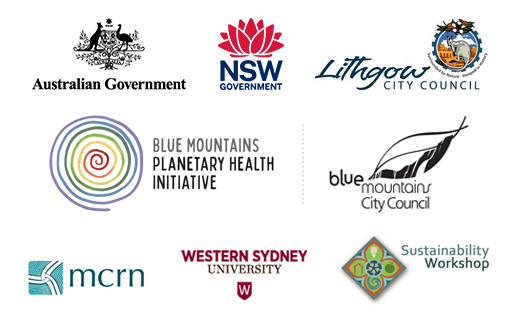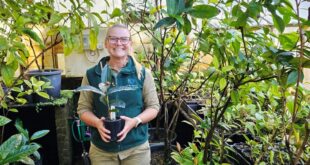
Andy Stevenson, Darling Causeway, Mount Victoria (Lis Bastian)
The 2013 fires damaged much of Andy Stevenson’s property on the Darling Causeway in Mount Victoria but Andy was determined to survive the next fire, while also creating a beautiful haven for family, guests and wildlife. The water management systems he put in place after 2013 created a property that was comfortable and lush throughout the drought, and survived both the catastrophic 2019 fires and the subsequent heavy rain events with minimal damage.
Key Points:
- Andy defended his property by making it into a moist living garden. He believes that to be a gardener you’ve got to be an optimist and optimism needs to be propagated because without optimism “we don’t have half of our engines running … and there’s work to be done…”
- Water management systems that reuse stormwater, grey water and blackwater, and build moist water retentive soils with drip irrigation, can reduce the risks associated with drought, fire, flood and heatwave.
Share this article:
Managing Water to Reduce Disaster Risk (Zac Agius, Lis Bastian and Hamish Dunlop)
When the catastrophic 2019 bush fire raced along the Darling Causeway to Mount Victoria, the second bushfire in six years to threaten their ridge-top home, Andy Stevenson’s adrenalin started pumping.
He and his partner had been anxiously preparing for this fire for weeks but, reliving the experience four years later, he recalls: “When a fire arrives you are stupid. It’s an emergency situation and everything is telling you to run; and everything is telling you to just leave. And if you’re not prepared you’re leaving to chance.”
As the fire neared, they were prepared.
Larry Howard, Captain of the Blackheath/Mount Victoria Rural Fire Brigade during the 2019/2020 fires, recalled assessing Andy’s property and being confident that he and his partner would be able to ‘stay and defend’: “They were so well prepared it saved us having to provide additional resources when we were so stretched,” Larry said.
When the fire arrived, Andy activated his strategically designed sprinkler system. Twelve sprinklers dumped 40,000l of recycled water onto his garden, and the RFS only needed to assist with spot fires.
It was so intense that as it closed in the RFS insisted they evacuate.
The next day they returned to a green oasis surrounded by a blackened hell-scape. The sprinkler system and the RFS had saved their home and garden, with the canopy and gardens preserved.
It was thrumming with life as birds, insects, lizards, wombats and other wildlife sought refuge from the charred and smouldering surrounds.
Andy and his partner had left nothing to chance. Part of their preparations had been to leave one tank full, and spray-pumps filled with water, so they could return to live on site after the fire front had moved through. They managed embers with the spray-pumps, spades and rakes.
After a severe seven-year drought, this was only possible because of the well-designed water management system Andy had been implementing.

An aerial view of the property in May 2023 (Hamish Dunlop)
Water Management to Reduce Disaster Risk
Andy sees water as his most valued resource.
He collects rainwater, uses it sparingly, and recycles all of it.
His property was so well prepared because stormwater was harvested and stored in a 20,000l tank for firefighters. Surplus was used for irrigation. Grey water was cleaned by an accredited grey water treatment system, and distributed through the garden with sub-surface drip irrigation. Black water was treated by a digestive ecomax which released the cleaned water into an evaporation trench. Together, all these systems helped create the moist soil sponge that could support life even in the longest drought. His garden became a cool, beautiful and liveable space which also provided food for humans and wildlife.
RFS Captain Larry Howard agreed with Andy’s strategy. “When we do hazard reductions we measure the moisture content of the soil. If it’s too wet we can’t burn it. Andy made sure his soil was wet. He also had enough water and sprinklers on site to defend his property. So many other properties had no water after the drought.”
Andy talks about building resilience in the face of drought and fire with water tanks, sprinklers, grey water and drip irrigation (Lis Bastian)
The engine room of the property: the pump connecting water tanks and pond to sprinklers (Lis Bastian)

The pump system (Lis Bastian)
The fire was immediately followed by rain, and lots of it. The City of the Blue Mountains was subsequently declared a natural disaster area four times for extreme wet weather events.
To stop erosion and protect his home, yet again, Andy asphalted his steeply sloping driveway to improve his stormwater harvesting system. The water was cleaned and stored in a tank for future irrigation and firefighting.
He also built gabion walls to slow water flow, erosion, and future creeping fire advances.

Gabion walls (Lis Bastian)
We caught up with Andy shortly after the fire in 2020, and then again after the flood and first waves of the pandemic in 2021. We regularly brought our students to his site to learn from his experience. Together we created the short video Balancing Grief with Optimism to share how he copes with a changing and challenging world.
Balancing Grief with Optimism, Living a Slow Life and Valuing Water as our Currency for the Future
Andy is a gardener and planned to defend his property by making it into a moist living garden. He believes that property defence starts with good soil, good soil containing water. His number one tool was drip irrigation.
“I think to be a gardener you’ve got to be an optimist and I really really feel that that needs to be propagated because without optimism we don’t have half of our engines running I don’t think, and there’s work to be done ….”
Taking Lessons Learnt to Canada
In June 2023, Andy and his partner moved to Canada to be near family.
Andy is now setting up another water management system as smoke fills the air with the worst wildfires in Canada’s modern history.

Andy Stevenson (supplied)
Take Action:
- If you are interested in exploring water solutions to reduce disaster risk on your property, learn more at Sydney Water here: https://www.sydneywater.com.au/education/wastewater-recycling/water-recycling.html and here: https://www.sydneywater.com.au/plumbing-building-developing/plumbing/recycled-water.html
- Contact Blue Mountains City Council here https://www.bmcc.nsw.gov.au/development to learn about approvals needed for safely implementing water management strategies.
Share this article:
This story has been produced as part of a Bioregional Collaboration for Planetary Health and is supported by the Disaster Risk Reduction Fund (DRRF). The DRRF is jointly funded by the Australian and New South Wales governments.




